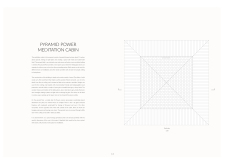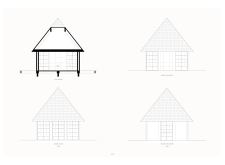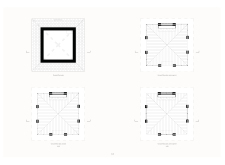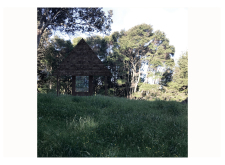5 key facts about this project
At its core, the project represents a harmonious relationship between built form and the natural landscape. The distinctive pyramid shape of the cabin is not only aesthetically appealing but also functionally significant, promoting a sense of balance and harmony. This form has been recognized across various cultures for its spiritual connotations, further enhancing the space’s purpose as a refuge for personal reflection. By utilizing a design that encourages upward movement, the architecture facilitates a deeper connection with the surrounding sky and trees, reinforcing a mindful experience.
The structure is composed of several important elements that contribute to its overall effectiveness as a meditation space. The use of solid wood as the primary material lends the cabin both structural integrity and warmth. This material choice is complemented by a biodegradable wood treatment, reflecting the project’s commitment to sustainability and environmental stewardship. Sliding glass doors at the entrance create an inviting threshold, allowing natural light to permeate the interior while providing unobstructed views of nature. This design element blurs the boundaries between indoor and outdoor spaces, a crucial aspect for a cabin dedicated to meditation where the natural environment plays a central role.
Inside, the cabin is thoughtfully organized to accommodate various activities, catering to individual meditation sessions as well as group gatherings. The interior space can be adapted according to the number of participants, facilitating practices that blend solitude and community. The pyramid room, featuring a telescope-like entrance, serves as a focal point for meditation, drawing users’ eyes upward and enhancing a sense of elevation and peace.
The architectural sections and plans of the Pyramid Power Meditation Cabin reveal additional layers of its design philosophy. The cross-sectional diagrams illustrate an effective use of light and ventilation, creating an atmosphere that promotes relaxation. The careful placement of windows and entry points is designed to maximize natural airflow and sunlight, crucial for maintaining a serene environment.
What sets this project apart is its innovative integration of sustainability principles throughout the design process. By prioritizing local materials and environmentally friendly treatments, the cabin minimizes its ecological footprint while still achieving aesthetic and functional goals. This attention to environmental impact fosters a deeper connection between the users and their surroundings, making the cabin a true extension of the landscape.
Overall, the Pyramid Power Meditation Cabin encapsulates a meaningful exploration of architectural design through its thoughtful form and materiality. By marrying the functional needs of a meditation space with an awareness of natural surroundings, it offers a unique solution for those seeking peace and reflection. For a comprehensive understanding of the architectural intentions and design specifics, readers are encouraged to explore the project presentation further, delving into the architectural plans, sections, and detailed designs that provide a fuller picture of this intriguing project.


























